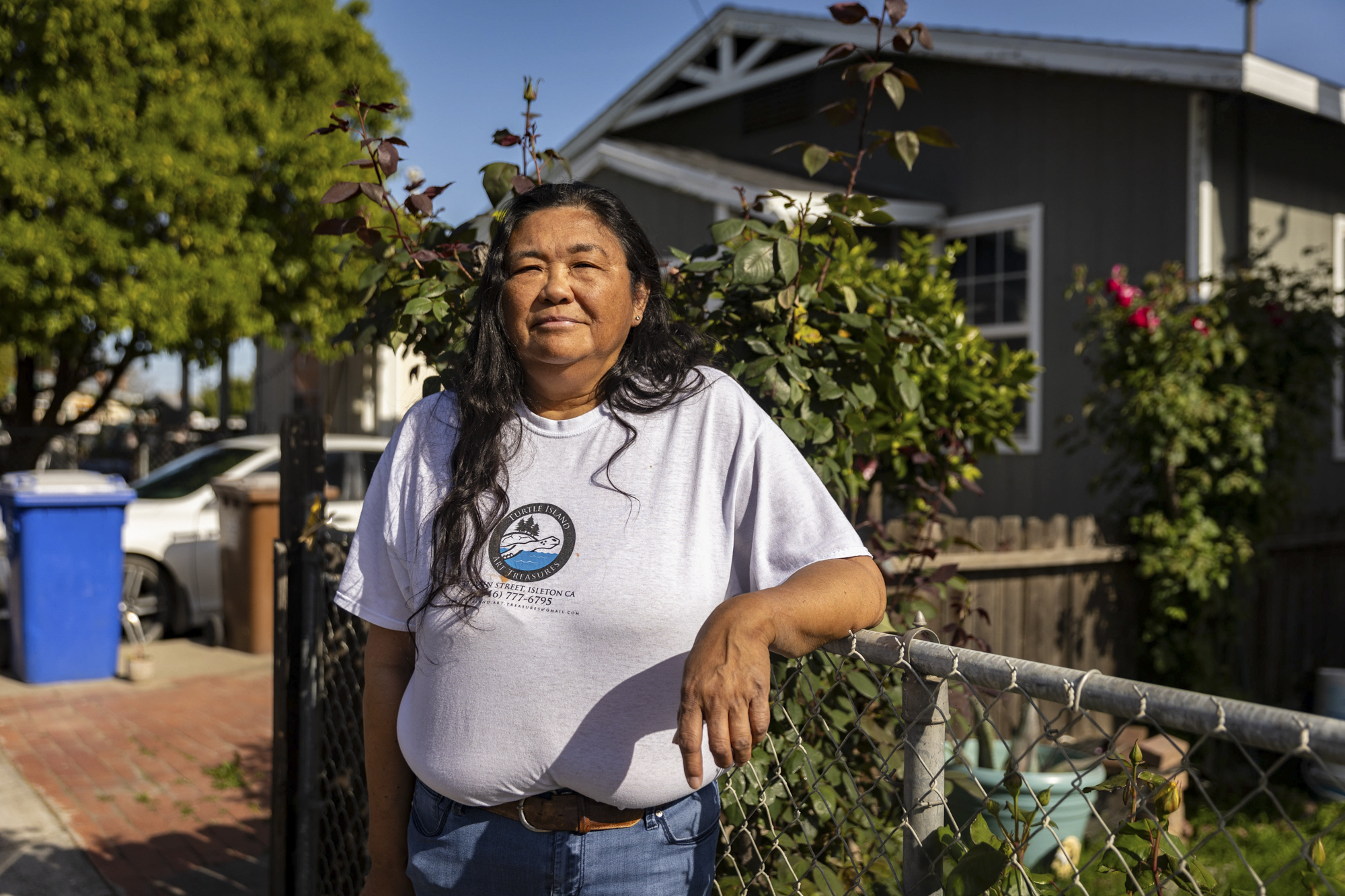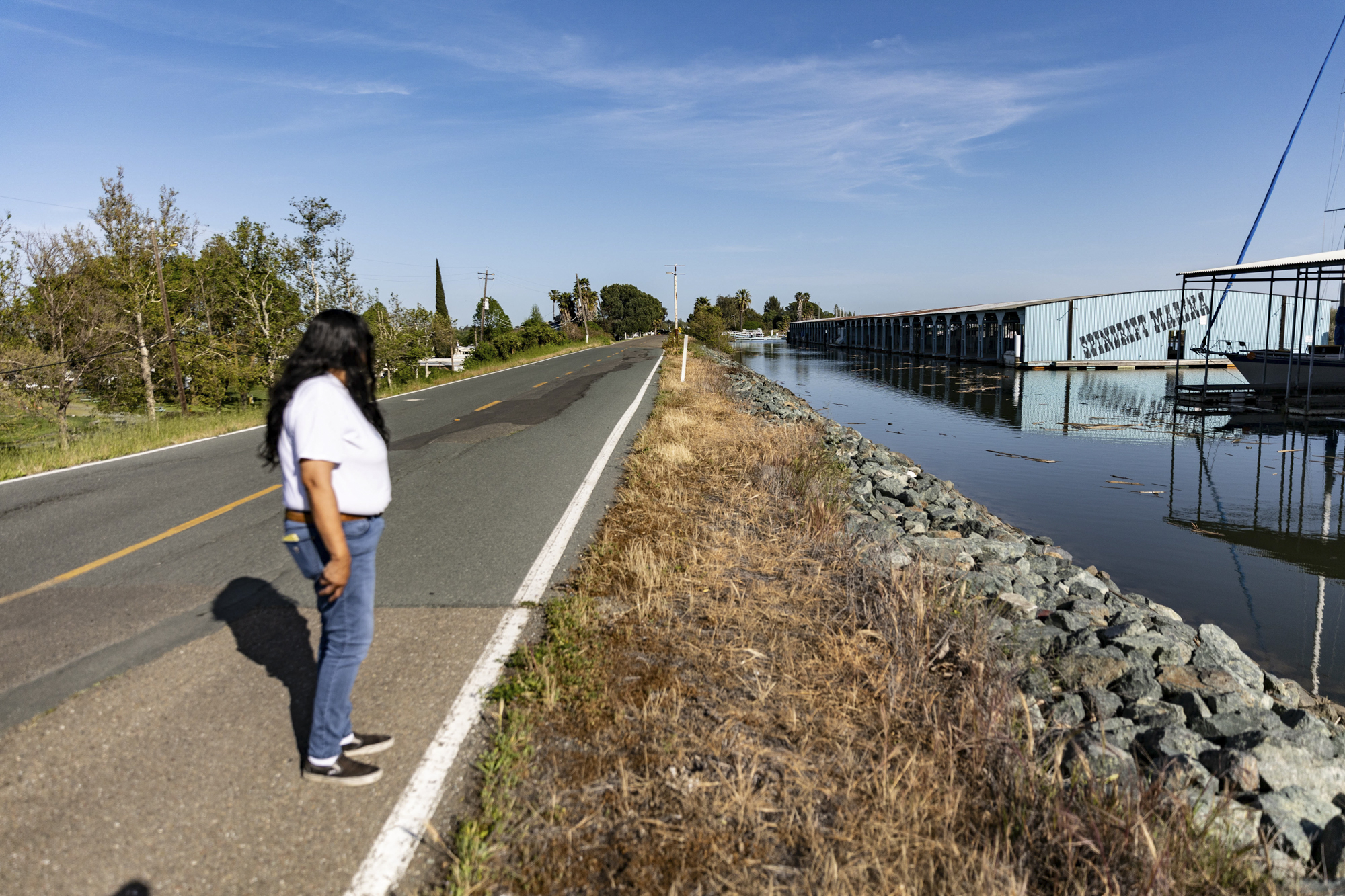Walton sat across a table from Vice Mayor David Kent at her bar on a Friday morning in January, drinking coffee. They mulled over how to preserve free-spirited Isleton — known for its crawdad and Spam festivals — and the troubles the historic city faces, some of which stem from the nearby Sacramento and San Joaquin rivers.
Isleton has a high risk of flooding but few resources, with a fifth of the city’s roughly 800 residents living in poverty. After rainstorms damaged its wastewater treatment facility, Isleton narrowly avoided bankruptcy this year. Walton consulted lawyers, accountants and flood insurance experts to bail it out.
“We’re in lightning mode,” Walton said. “There’s been a tendency for things to take a while to come to fruition here — you might call that ‘Delta time.’ But now, the faster, the better, so we can start to build up our city again.”
 Iva Walton, Mayor of Isleton, poses for a photo at her bar, Mei Wan Beer Room, in Isleton on April 9, 2025. (Gina Castro/KQED)
Iva Walton, Mayor of Isleton, poses for a photo at her bar, Mei Wan Beer Room, in Isleton on April 9, 2025. (Gina Castro/KQED)
As climate change drives up flooding risk, the safest move for Isleton residents might be to abandon their small city — but short of that drastic option, insurance could provide a safety net. Now, with help from researchers, the state has funded its first community flood program, providing one private insurance policy for all Isleton residents at no cost.
Isleton is piloting community-based insurance for California, which desperately needs alternatives. Wildfires supercharged by climate change have cratered the home insurance market — and many Californians don’t buy flood insurance at all, even as severe storms batter the state and its aging levees.
Isleton hoped to fund the program independently after the pilot ends in 2027 by establishing a parcel tax, but many residents seem unsupportive of paying it. Despite the uncertain future, Isleton’s new leadership said they plan to lock in the insurance policy this month.
“The idea of insurance for the city of Isleton is hugely important and our number-one priority,” Kent said.
Twenty-six miles of underperforming levees encircle Isleton, which sits on one of the Delta’s many islands. The city ranges from around 6 feet below to 6 feet above sea level. The region is accustomed to flooding, but the June 21, 1972, flood was the most infamous in Isleton.
Isleton resident Pam Bulahan was 9 years old at the time. Her family received word before dawn of a levee breach. They borrowed a flatbed truck and scrambled to load up their nice furniture.
“I’m watching the water creep across the road,” remembered Bulahan, who today sits on the City Council with Walton and supports the insurance pilot. “It was the eeriest thing I ever saw. I figured the houses were going down, and they did.”
 Pam Bulahan poses for a photo outside of her home in Isleton, which flooded in 1972, on April 9, 2025. She was only 9 years old when her family had to evacuate during the 1972 flood after a levee was breached. (Gina Castro/KQED)
Pam Bulahan poses for a photo outside of her home in Isleton, which flooded in 1972, on April 9, 2025. She was only 9 years old when her family had to evacuate during the 1972 flood after a levee was breached. (Gina Castro/KQED)
By sunrise, up to 5 feet of floodwater soaked her property. Around 200 buildings remained flooded for months, forcing the entire community to evacuate. It took Bulahan’s family a couple of years and a loan to repair their house, where she still lives today.
Most recently, in 2023, excessive rainfall cracked sewer pipes and overtopped Isleton’s wastewater treatment ponds, spilling sewage into the neighboring rivers — major sources of drinking water for the Bay Area and across the state.
In response to disasters like this, FEMA can reimburse cities for public infrastructure damage. But as Isleton awaited FEMA’s relief, Walton said the city took out a bridge loan to assist with the repairs — and then struggled to make payments. Added to a long history of financial mismanagement, the city this year had to lay off 12 of its 16 staff members to avoid bankruptcy.
Isleton’s challenges are not going away. With climate change, models predict annual flood damages from atmospheric rivers in the western U.S. could increase from $1 billion up to $3 billion by the end of this century.
 Pam Bulahan points to the San Joaquin River, at the site where a levee breach caused the 1972 flood, on W Brannan Island Road, in Isleton, on April 9, 2025. (Gina Castro/KQED)
Pam Bulahan points to the San Joaquin River, at the site where a levee breach caused the 1972 flood, on W Brannan Island Road, in Isleton, on April 9, 2025. (Gina Castro/KQED)
Together, Walton, Kent and Bulahan form the board of Isleton’s Geologic Hazard Abatement District, the entity tasked with purchasing the new community-wide insurance policy. With the help of the engineering firm ENGEO, the district plans to finalize the policy in May.
At the district’s planning meeting in January, Walton clunked her water bottle on the table: “Call to order.”
The group was joined by Kathy Schaefer, an insurance advisor who left her longtime job as a FEMA engineer to pursue her civil and environmental engineering PhD from UC Davis. She took an interest in Isleton’s high flood risk. In her December dissertation, Schaefer outlined a program she argued offers more affordable and effective private insurance for Isleton than FEMA’s, and then successfully lobbied the state to fund that program.
“I became convinced that FEMA was fundamentally broken,” Schaefer explained. “I went back to school to find out exactly what the problem was and how we could solve it.”
 Kathy Schaefer points to elevated homes, which meet FEMA requirements, in Isleton on April 9, 2025. (Gina Castro/KQED)
Kathy Schaefer points to elevated homes, which meet FEMA requirements, in Isleton on April 9, 2025. (Gina Castro/KQED)
Schaefer considers FEMA too costly and slow, leading many people to avoid flood insurance altogether. FEMA not only provides flood disaster funds for public infrastructure but, unlike the separate and privatized home insurance market, also sells most individual flood insurance policies. Although FEMA’s National Flood Insurance Program is widely available, it only covers around 2% of California properties.
Because Isleton falls into its high-risk flood zone, FEMA mandates that most homeowners with a mortgage buy flood insurance. But Schaefer found that less than a quarter of the some 500 Isleton households comply.
Schaefer fought hard to bring dollars to Isleton, so the entire community could have insurance.



















